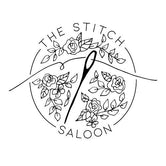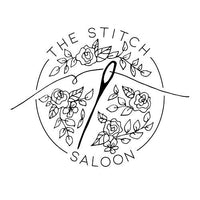The simple and timeless Irish Chain quilt pattern will long be a favourite of mine, and one that can suit so many different styles and personalities. It's traditional, but can also look a little bit modern, so it's bound to suit anyone you need to whip up a quick quilt for.
It is also a great pattern for a beginner quilter to make! It's got some big cuts, some long and straight seams, and just the right amount of seam matching for you to practice without getting too bored or frustrated. I've written the below tutorial to make your own baby size Irish Chain quilt, about 40" x 40" / 100cm x 100cm when it is finished.
While the Irish Chain quilt is certainly not a new or unique design, and there are so many other wonderful tutorials out there, I wanted to write my own tutorial for a few reasons:
1. I love a square quilt, particularly when it will be used for a baby playmat. I wasn't able to find a square Irish Chain quilt tutorial that made the size I was after, so here we are!
2. I love a quilt pattern that uses strip sets to make blocks, but don't much love big leftover pieces. I never really know what I can make with the leftovers and they will sit in my scrap bin for too long. My instructions include a bit of strategic unpicking to make the most of your fabric, resulting in needing to purchase less fabric, and have fewer scraps at the end!
3. I really don't like having to piece backing fabric together for a baby sized quilt and am much more likely to make a quilt that can fit on one WOF cut. Unless some clever piecing is done to minimise the amount of fabric required to piece your backing (a blog post for another day!), a lot of the extra fabric used to piece the backing ends up being put into the scrap pile. Assuming you are quilting your quilt on your own machine (as opposed to sending to a long-arm quilter to finish), you can fit this quilt on one WOF piece of fabric, and still have a few inches to grab onto while you are quilting, which has always been enough for me.
So without further ado, here is how to make your own baby sized Irish Chain quilt!
Fabric Requirements:
Fabric A/Background (Sage): 1.25 metres
Fabric B/Accent (Cream): 1/2 metre (please note this measurement does not leave any wiggle room for errors, therefore you may wish to order more if you aren't totally confident!)
Backing: 1.25 metres
Binding: 1/2 metre
Note: this tutorial assumes your fabric is at least 42" wide without selvedges. Most Art Gallery Fabrics quilting cottons will suit this, however some manufacturers' width of fabric is closer to 40". The fabric requirements above will still work, however the piecing process will be slightly different - this will be noted below!
Cutting Instructions:
Give your fabrics a nice press to get as many creases out as possible.
From Fabric A/Background, cut:
- (6) 2.5" x WOF (width of fabric) strips
- (4) 6.5" x WOF strips. Sub-cut each strip into (6) 6.5" squares (for a total of (24) 6.5" squares)
From Fabric B/Accent, cut:
- (8) 2.5" x WOF strips
Piecing Instructions:
1. Using 1/4" seam allowance, sew (1) 2.5" strip from Fabric A and (1) 2.5" strip from Fabric B together (Fig 1). Press the seam towards the darker fabric.

2. Sew (1) 2.5" Fabric A strip to the other side of the Fabric B strip previously sewn (Fig 2). Press the seam towards the darker fabric. You will now have (1) ABA strip set.

Repeat step 1 and 2 to create another ABA unit. You will need a total of (2) ABA units.
3. Sew (1) 2.5" strip from Fabric A and (1) 2.5" strip from Fabric B together (Fig 3). Press the seam towards the darker fabric.

4. Sew (1) 2.5" Fabric B strip to the other side of the Fabric A strip previously sewn (Fig 4). Press the seam towards the darker fabric. You will now have (1) BAB strip set.

Repeat step 1 and 2 to create another BAB unit. You will need a total of (2) BAB units.
5. Using (1) ABA unit, trim off the edges from one side of the strip set and sub-cut the strip set into (16) 2.5" pieces and set aside (Fig 5). If you are able to cut any more than 16 pieces from this strip set, please do so!

6. Using the second ABA unit, trim off the edges from one side and sub-cut (9) 2.5" pieces (Fig 6). You will have a total of (25) ABA 2.5" x 6.5" pieces.

7. Trim off the edges of both BAB strip sets and sub-cut each strip set into (16) 2.5" pieces, for a total of (32) (Fig 7). If you can squeeze any more from either strip set, do it! I ended up with 34 but not all fabric widths will allow this extra one.

Now it's time to grab your seam ripper, but not for anything you've done wrong! We are about to do some unpicking to make the most out of the fabric and minimise leftovers.
8. Unpick (1) Fabric A strip from the leftover ABA strip set and set aside, leaving a leftover unit of one A and one B strips still sewn together (Fig 8).

9. Attach (1) 2.5" Fabric B strip to the other side of Fabric A of the leftover unit, to create a partial BAB unit (Fig 9).

10. Trim off the uneven edge of the partial BAB unit and sub-cut this partial strip set into as many 2.5" pieces as you can - you should yield about 8, but cut any more that you can too (Fig 10)!

11. You should have one last 2.5" Fabric B strip remaining. Cut this strip in half, resulting in (2) 21" pieces (Fig 11). Sew one piece to the leftover Fabric A strip that you unpicked earlier, and press the seam towards the darker fabric. Sew the last Fabric B strip to the other side of Fabric A and press towards the darker fabric. You will have another partial BAB unit (Fig 12).


12. Trim off the uneven edge of the partial BAB unit and sub-cut the remaining pieces required. You will need a total of (50) 2.5" BAB pieces altogether. You will have at least 32 from Step 7, another 8 or so from Step 10, so you will need to cut another (8-10) 2.5" pieces. Cut as many as you can from this partial BAB unit (Fig 13 - it will be about 8), and if you are still short a couple of pieces, you should have enough scraps to make a couple more units using the leftover Fabric B strip from Steps 9 and 10, and the offcuts from your 6.5" square strip cuts at the very start (Fig 14).


Note: if your fabric is not 42" wide without selvedges (as noted in the fabric requirements), you may not have enough on your offcuts from the 6.5" square strip to use for these last few units. You should be able to cut another strip from your leftover Fabric A fabric and use the leftover Fabric B strip from Steps 9 and 10 to piece together another small strip set to get your final pieces.
You will have a total of (25) 2.5" ABA pieces and a total of (50) 2.5" BAB pieces.
13. Sew (1) ABA piece to (1) BAB piece (Fig 15). The seams should naturally "nest" together as the seams have been pressed in opposite directions, to create less bulk. Use pins or clips to hold the seams in place to help your points meet up when sewn together. Press the seam towards one side or open if preferred.
14. Sew (1) BAB piece to the other side of the ABA piece (Fig 15), nesting the seams. Press the seam towards one side or open if preferred. You will now have a lovely nine-patch unit!

Repeat Steps 13 and 14 to create a total of (25) nine-patch units.
15. It's time to lay out your quilt and sew it all together! Lay out the first row starting with a nine-patch unit, then alternating with a 6.5" square. The row will be 7 blocks across. Start the second row with a 6.5" square and alternate with a nine-patch unit. Repeat this process until you have laid out all the blocks. The quilt will be 7 blocks across and 7 blocks down (Fig 16).

16. Lay the first two blocks of the first row right sides together and sew (Fig 17). Place the next square right sides together and sew. Continue this for the remainder of the row until all blocks are sewn together, then repeat for all rows of the quilt. Press the seams of each row towards the 6.5" square (i.e. away from the nine-patch unit).

17. Lay the first row and the second row right sides together, nesting the seams and sew. Press towards one side, or open if preferred. Add the third row to the bottom of the second row and sew together. Continue adding the rows until they are all sewn together, and you've got a finished quilt top!

18. Prepare your backing. I sized this quilt especially to fit onto one width of fabric, so you don't have to worry about piecing a backing - this will both save you money at the start as you don't have to purchase as much fabric for the backing, and it will also save you from having a really large scrap that often comes from needing to use a pieced backing for a baby size quilt.
Note: if you are intending to have a long-arm quilter quilt your quilt, you may need to piece a backing for it to be large enough. Check your long-arm quilter's specific requirements, however most require at least 4" on each side of the quilt to be able to load your quilt onto their machines correctly, so the one WOF piece will not be wide enough and you will need to either use a wideback fabric instead, or piece your backing.
19. Quilt your quilt sandwich however you like (my personal favourite for an Irish Chain is a diagonal grid, but really anything will look great!), and then you are ready to bind your quilt! I'll be sharing my favourite way of binding in a future blog post, but for now, if you have not bound a quilt before and are looking for some extra support, head over to this great post from Suzy Quilts on binding a quilt.
Yay! You did it! Now snuggle up and enjoy your beautiful quilt.



1 comment
This is a wonderful tutorial! Every single step, even the most basic and obvious, is explained clearly and simply. It is great to see a quilt shop owner, a quilt designer and bundle fabric selector extraordinaire that also has these amazing skills in adult education. This is a rare thing in the quilting world. Thank you Claire Freund 💕